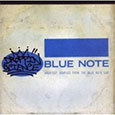Droppin’ Science: Samples From Blue Note Lab
Even today, listening to jazz saxophonist Donaldson’s 1969 take on Johnnie Taylor’s chitlin-circuit banger “Who’s […]

Even today, listening to jazz saxophonist Donaldson’s 1969 take on Johnnie Taylor’s chitlin-circuit banger “Who’s Makin’ Love (To Your Old Lady),” it’s a stretch to locate the primordial DNA of ’90s hip-hop in the mix. But just as Donaldson swiped a funky backbeat and a Blue loop guitar lick from soul music, once you slow things down and pump up the bass, there’s Marley Marl and “Droppin’ Science” stealing it right back. On Droppin’ Science: Greatest Samples From the Blue Note Lab, the venerable jazz label not only touts its place in 1990s hip-hop history, but reexamines the jazz-funk that couldn’t save the label from its first demise (in 1979), yet proved to be one of its most important legacies.
From 1988 and “Droppin’ Science” through to Dr. Dre’s 1999 track “The Next Episode,” Capitol/Blue Note’s ’70s back catalog provided the blueprint for hip-hop’s expansion–into textural and textual subtlety–just as James Brown and Chic had done for hip-hop’s foundation. Samples like “Who’s Makin’ Love” as well as “It’s Your Thing” by Donaldson, the basis for “Punks Jump Up to Get Beat Down,” Donald Byrd’s “Think Twice,” and Lonnie Smith’s “Spinnin’ Wheel” (both used extensively by De La Soul and A Tribe Called Quest), and a multitude of others made Blue Note a crate digger’s cri de coeur during the glory days of hip-hop sampling.
No one knows this better than Eli Wolf, Blue Note Records V.P. for A&R. A thirty-something jazz saxophonist and hip-hop-phile, Wolf has had a hand in much of Blue Note’s extensive history of embracing its own sample- and remix-ability, from dabbling on the New Groove projects to co-producing Madlib’s Shades of Blue, to compiling Droppin’ Science. “It was a change [in hip-hop],” says Wolf of what he calls the music’s Blue Note era, “but really it was more of an evolution. As a hip-hop fan and a jazz fan at that time in the late ’80s and early ’90s, I really saw the two coalesce–with the Native Tongues era, for example, there was a transition, going from straight soul and funk to more jazzy sounds.”
To illustrate that era, Wolf has assembled a collection of recordings judged on two qualifications: the cultural impact of the music each is sampled in, and how the song stands on its own. Blue Note’s breaks contributions and seminal acid-jazz sounds have been touted on compilations for years, for example on the Blue Break Beats series, but Droppin’ Science succeeds in two ways in which others have often failed. As a look back at the broad creativity and production genius of 1990s hip-hop, Science shows us producers and crate diggers willing and able to ignore old hip-hop standards in order to find sounds more aligned to their increasing musicality and studio maturity.
Perhaps more importantly, however, Science provides a new look at Blue Note’s own 1970s output. In his 2003 book, Blue Note Records: The Biography, the late, great jazz curmudgeon Richard Cook devotes mere pages to the label’s entire ’70s existence. “The label floundered around in search of a direction,” he says, dismissing the likes of Donald Byrd’s Mizell Brothers-produced ’70s albums as “increasingly silly.” Maybe so, to an avant-gardist like Cook. To the rest of the world, those productions provided the dramatic and orchestral jazz-funk sounds that defined the time when hip-hop became the most commercially and artistically important music in the world, and gave voice to everything from Dre’s Gs-and-drama swathes of sound to J Dilla’s reinvention of the hip-hop producer.

